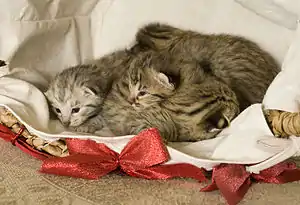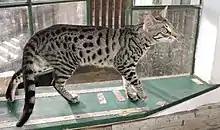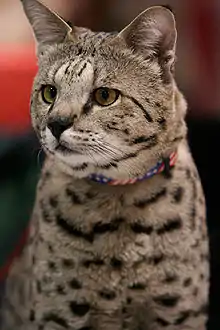Savannah cat
The Savannah is a hybrid cat breed. It is a cross between a serval and a domestic cat.[1][2][3]
| Savannah | |
|---|---|
 | |
| Origin | United States |
| Breed standards | |
| TICA | standard |
| CCA-AFC | standard |
| Notes | |
Savannahs are about the size of a medium dog | |
| Feline hybrid (Felis catus × Leptailurus serval) | |
History
The Savannah cat is the largest of the cat breeds. A Savannah cat is a cross between a domestic cat and a serval, a medium-sized, large-eared wild African cat. The unusual cross became popular among breeders at the end of the 1990s, and in 2001 The International Cat Association (TICA) accepted it as a new registered breed. In May 2012, TICA accepted it as a championship breed.
On April 7, 1986, Judee Frank crossbred a male serval, belonging to Suzi Woods, with a Siamese domestic cat to produce the first Savannah cat (named Savannah).[4] In 1996, Patrick Kelley and Joyce Sroufe wrote the original version of the Savannah breed standard and presented it to the TICA board, and in 2001, the board accepted the breed for registration. The Savannah cat can come in different colors and patterns; however, TICA breed standards accept only spotted patterns with certain colors and color combinations.
Physical features and breeding techniques

The Savannah's tall and slim build give them the appearance of greater size than their actual weight. Size is very dependent on generation and sex, with F1 hybrid male cats usually being the largest.
F1 and F2 generations are usually the largest, due to the stronger genetic influence of the African serval ancestor. As with other hybrid cats such as the Chausie and Bengal cat, most first-generation cats will possess many of the serval's exotic traits, while these traits often diminish in later generations. Male Savannahs tend to be larger than females.
Early-generation Savannahs can weigh 4.5 to 11 kg with the most weight usually attributed to the F1 or F2 neutered males due to genetics. Later-generation Savannahs are usually between 3.5 and 7.7 kg.[5] Because of the random factors in Savannah genetics, size can vary significantly, even in one litter.
The coat of a Savannah should have a spotted pattern, the only pattern accepted by the TICA breed standard.[6] Non-standard patterns & colors include rosetted, marble, snow color (point), blue color, cinnamon color, chocolate color, lilac (lavender) and other diluted colors derived from domestic sources of cat coat genetics.
TICA's breed standard calls for brown-spotted tabby (cool to warm brown, tan or gold with black or dark brown spots), silver-spotted tabby (silver coat with black or dark grey spots), black (black with black spots), and black smoke (black-tipped silver with black spots) only.[6]
Domestic outcrosses from the early days in the 1990s have greatly impacted the breed's development in both desired and non-desired traits. As of 2012 most breeders perform Savannah-to-Savannah pairings; using outcrosses is considered less than desired. There are no longer any permitted domestic outcrosses for the Savannah breed now that TICA championship status has been achieved. Previously domestic outcrosses for the Savannah breed that were permissible in TICA were the Egyptian Mau, the Ocicat, the Oriental Shorthair, and the Domestic Shorthair.
Outcrosses that are "impermissible" according to the TICA breed standard breeds include the Bengal and Maine Coon cats. These impermissible breeds can bring many unwanted genetic influences. Outcrosses are very rarely used as of 2012, as many fertile Savannah males are available for studs. Breeders prefer to use a Savannah, rather than a non-Savannah breed, with the serval to produce F1s in order to maintain as much breed type as possible.
A Savannah's exotic look is often due to the presence of many distinguishing serval characteristics. Most prominent of these include the various color markings; tall, deeply cupped, wide, rounded, erect ears; very long legs; fat, puffy noses; and hooded eyes. The bodies of Savannahs are long and leggy; when a Savannah is standing, its hind end is often higher than its prominent shoulders. The small head is taller than wide, and the cat has a long, slender neck.[7] The backs of the ears have ocelli—a central light band bordered by black, dark grey or brown, giving an eye-like effect. The short tail has black rings, with a solid black tip. The eyes are blue in kittens (as in other cats), and may be green, brown, gold or a blended shade in the adult. The eyes have a "boomerang" shape, with a hooded brow to protect them from harsh sunlight. Ideally, black or dark "tear-streak" or "cheetah tear" markings run from the corner of the eyes down the sides of the nose to the whiskers, much like that of a cheetah.
Reproduction and genetics

As Savannahs are produced by crossbreeding servals and domestic cats, each generation of Savannahs is marked with a filial number. For example, the cats produced directly from a serval × domestic cat cross are termed F1, and they are 50% serval.
F1 generation Savannahs are very difficult to produce, due to the significant difference in gestation periods between the serval and a domestic cat (75 days for a serval and 65 days for a domestic cat) and incompatibilities between the two species' sex chromosomes. Pregnancies are often absorbed or aborted, or kittens are born prematurely. Also, servals can be very picky in choosing mates, and often will not mate with a domestic cat.

Savannah backcrosses, called the BC1 generation, can be as high as 75% serval. Such 75% cats are the offspring of a 50% F1 female bred back to a serval. Cases of 87.5% BC2 Savannah cats are known, but fertility is questionable at those serval percentages. More common than a 75% BC1 is a 62.5% BC1, which is the product of an F2A (25% serval) female bred back to a serval. The F2 generation, which has a serval grandparent and is the offspring of the F1 generation female, ranges from 25% to 37.5% serval. The F3 generation has a serval great grandparent, and is at least 12.5% serval.
The F4 generation is the first generation that can be a "stud book tradition" (SBT) cat and is considered "purebred". A Savannah cross may also be referred to by breeders as "SV × SV" (where SV is the TICA code for the Savannah breed). Savannah generation filial numbers also have a letter designator that refers to the generation of SV-to-SV breeding. The designation A means one parent is a Savannah and the other is an outcross. B is used when both parents are Savannahs, with one of them being an A. The C designation is used when both parents are Savannahs and one of them is a B. Therefore, A × (any SV) = B; B × (B,C,SBT) = C; C × (C, SBT) = SBT, SBT × SBT = SBT. F1 generation Savannahs are always A, since the father is a nondomestic outcross (the serval father). The F2 generation can be A or B. The F3 generation can be A, B or C. SBT cats arise in the F4 generation.

Being hybrids, Savannahs typically exhibit some characteristics of hybrid inviability. Because the male Savannah is the heterogametic sex, they are most commonly affected, in accordance with Haldane's rule. Male Savannahs are typically larger in size and sterile until the F5 generation or so, although the females are fertile from the F1 generation. As of 2011, breeders were noticing a resurgence in sterility in males at the F5 and F6 generations. Presumably, this is due to the higher serval percentage in C and SBT cats. The problem may also be compounded by the secondary nondomestic genes coming from the Asian leopard cat in the Bengal outcrosses that were used heavily in the foundation of the breed.
Females of the F1–F3 generations are usually held back for breeding, with only the males being offered as pets. The reverse occurs in the F5–F7 generations, but to a lesser degree, with the males being held as breeding cats and females primarily offered as pets.
Temperament

The cats are known for their loyalty, and they will follow their owners around the house. They can also be trained to walk on a leash and to fetch.[8]
Some Savannahs are reported to be very social and friendly with new people and other cats and dogs, while others may run and hide or revert to hissing and growling when seeing a stranger. Exposure to other people and pets is most likely the key factor in sociability as Savannah kittens grow up. Breeders report that roughly 50% of first generation savannah kittens exhibit fear and anxious behaviors when initially placed in their new home. These behaviors if not corrected at an early age carry through to adulthood.[9]
An often-noted trait of the Savannah is its jumping ability. They are known to jump on top of doors, refrigerators and high cabinets. Some Savannahs can leap about 8 feet (2.5 m) high from a standing position. Savannahs are very inquisitive. They often learn how to open doors and cupboards, and anyone buying a Savannah will likely need to take special precautions to prevent the cat from getting into trouble.
Many Savannah cats do not fear water, and will play or even immerse themselves in water. Some owners even shower with their Savannah cats.[10] Presenting a water bowl to a Savannah may also prove a challenge, as some will promptly begin to "bat" all the water out of the bowl until it is empty, using their front paws.
Health considerations
Hypertrophic cardiomyopathy (HCM) is a health concern in many pure breed cats. The Bengal cat (a similar hybrid) is prone to HCM, and servals may themselves be prone to HCM. Several responsible Bengal breeders have their breeder cats scanned for HCM on an annual basis, though this practice is not as widespread in the Savannah community.
Some veterinarians have noted servals have smaller livers relative to their body sizes than domestic cats, and some Savannahs inherit this, but it is not know to be of any medical consequence. There are no known medical peculiarities of hybrid cats requiring different medical treatments than domestic cats, despite what many breeders may believe. The blood test reference ranges of Savannahs are not known to be different from the typical domestic cat, despite its serval genes.
Like domestic cats, Savannahs and other domestic hybrids (such as Bengals) require appropriate anesthesia based on their medical needs but do not have specific requirements. It is unclear among the veterinary community why ketamine has been listed as causing ill effects; this is not accurate. It is possible this comes from a misunderstanding of the drug and its common effects, since ketamine cannot be used alone as an anesthetic. Ketamine has been found safe for use in servals together with medetomidine and butorphanol and with the antagonist atipamezole.[11][12]
In the United States, rabies vaccines are recommended but not approved for non-domestic cats. If a non-domestic cat bites someone, it will be treated as "unvaccinated", whether it has been given a vaccine or not. This means a state veterinarian may require a cat who has bitten someone to be euthanized or quarantined according to state laws.
Some breeders say that Savannah cats have no known special care or food requirements, while others recommend a diet with no grains or byproducts. Some recommend a partial or complete raw food diet with at least 32% protein and no byproducts. Some recommend calcium and other supplements, especially for growing cats and earlier generations. Others consider it unnecessary or even harmful.[7] Most Savannah breeders agree that Savannahs have a need for more taurine than the average domestic cat and therefore recommend taurine supplements, which can be added to any food type.
Ownership laws
Laws governing ownership of Savannah cats in the United States vary according to state. The majority of states follow the code set by the United States Department of Agriculture, which defines wild or domesticated hybrid crosses as domesticated. Some states have set more restrictive laws on hybrid cat ownership, including Hawaii, Massachusetts, Texas and Georgia. Some cities may have laws that differ from the state. For example, Savannahs more than five generations from the serval are allowed by New York state, but not by the city of New York.[13]
The Australian federal government has banned the importation into Australia of the Savannah cat, as the larger cats could potentially threaten species of the country's native wildlife not threatened by smaller domestic cats.[14][15] A government report on the proposed importation of the cats has warned the hybrid breed may introduce enhanced hunting skills and increased body size into feral cat populations, putting native species at risk.[16][17]
Savannah cats are legal in every province of Canada, although some provinces have restrictions on the ownership of F1 and F2 generations, and importing Savannahs from the United States requires rabies vaccination and special permits.[18]
Many other nations have few or no restrictions on F2 and later generations.[19]
See also
References
- Levy, Ariel (April 29, 2013). "Living-Room Leopards". The New Yorker. Retrieved April 6, 2018.
- Markula, Anna; Hannan-Jones, Martin & Csurhes, Steve (2009). "Invasive animal risk assessment: Serval hybrids" (PDF). State of Queensland Department of Agriculture and Fisheries. Retrieved October 15, 2019.
- "Savannah Introduction". The International Cat Association. Archived from the original on April 6, 2018. Retrieved April 6, 2018.
- "Blast from the Past.... The Very First F1 Savannah" (PDF). Feline Conservation Federation. 51 (4): 32. 2007. (Original essay: Wood, Suzi (November 1986). LIOC-ESCF 30 (6): 15.)
- "PestSmart Report" (PDF).
- "TICA Breed Standard for Savannahs (SV)" (PDF). The International Cat Association. Retrieved April 14, 2017.
- "Petworld". Vol. 6 no. 6. Retrieved November 24, 2006. Cite magazine requires
|magazine=(help) - Gerasole, Vince (February 19, 2004). "Inside Chicago: Cats Who Act Like Dogs". CBS2 Chicago. Archived from the original on April 6, 2004. Retrieved August 26, 2006.
- "F1 behavior Report".
- Adamson, Eve (2006–2007). "Meet the Breeds". Kittens USA. 10: 64–69.
- Moresco, Anneke; Larsen, R. Scott & Lassiter, Angela J. (June 1, 2009). "Evaluation of the effects of naloxone on recovery time and quality after ketamine-medetomidine-butorphanol anesthesia in servals (Leptailurus serval)". Journal of Zoo and Wildlife Medicine. 40 (2): 289–295. doi:10.1638/2008-0078.1.
- Langan, Jennifer N.; Schumacher, Juergen; Pollock, Christal; Orosz, Susan E.; Jones, Mike P. & Harvey, Ralph C. (September 1, 2000). "Cardiopulmonary and anesthetic effects of medetomidine-ketamine-butorphanol and antagonism with atipamezole in servals (Felis serval)". Journal of Zoo and Wildlife Medicine. 31 (3): 329–334. doi:10.1638/1042-7260(2000)031[0329:CAAEOM]2.0.CO;2.
- Saulny, Susan (May 12, 2005). "What's Up, Pussycat? Whoa!". The New York Times. Retrieved November 21, 2015.
- "Scientists rally to keep out 'supercats'". ABC News. June 13, 2008. Retrieved October 3, 2009.
- Cooper, Dani (June 23, 2008). "Savannah cats not worth risk, says report". ABC Science. Retrieved October 3, 2009.
- "Savannah cats banned from Australia". The Age. Melbourne. Australian Associated Press. August 3, 2008. Archived from the original on December 30, 2009. Retrieved October 3, 2009.
- "Final environmental assessment of the suitability of the import of the Savannah Cat (Domestic Cat x Serval hybrid specimens) into Australia". Department of the Environment, Australian Government. July 24, 2008. Retrieved October 15, 2019.
- "Permits for Savannahs". Savannahs In Canada. Archived from the original on April 16, 2018. Retrieved April 2, 2016.
- "International Laws". Hybrid Law. Archived from the original on October 21, 2013. Retrieved February 7, 2014.
External links
| Wikimedia Commons has media related to Savannah cats. |